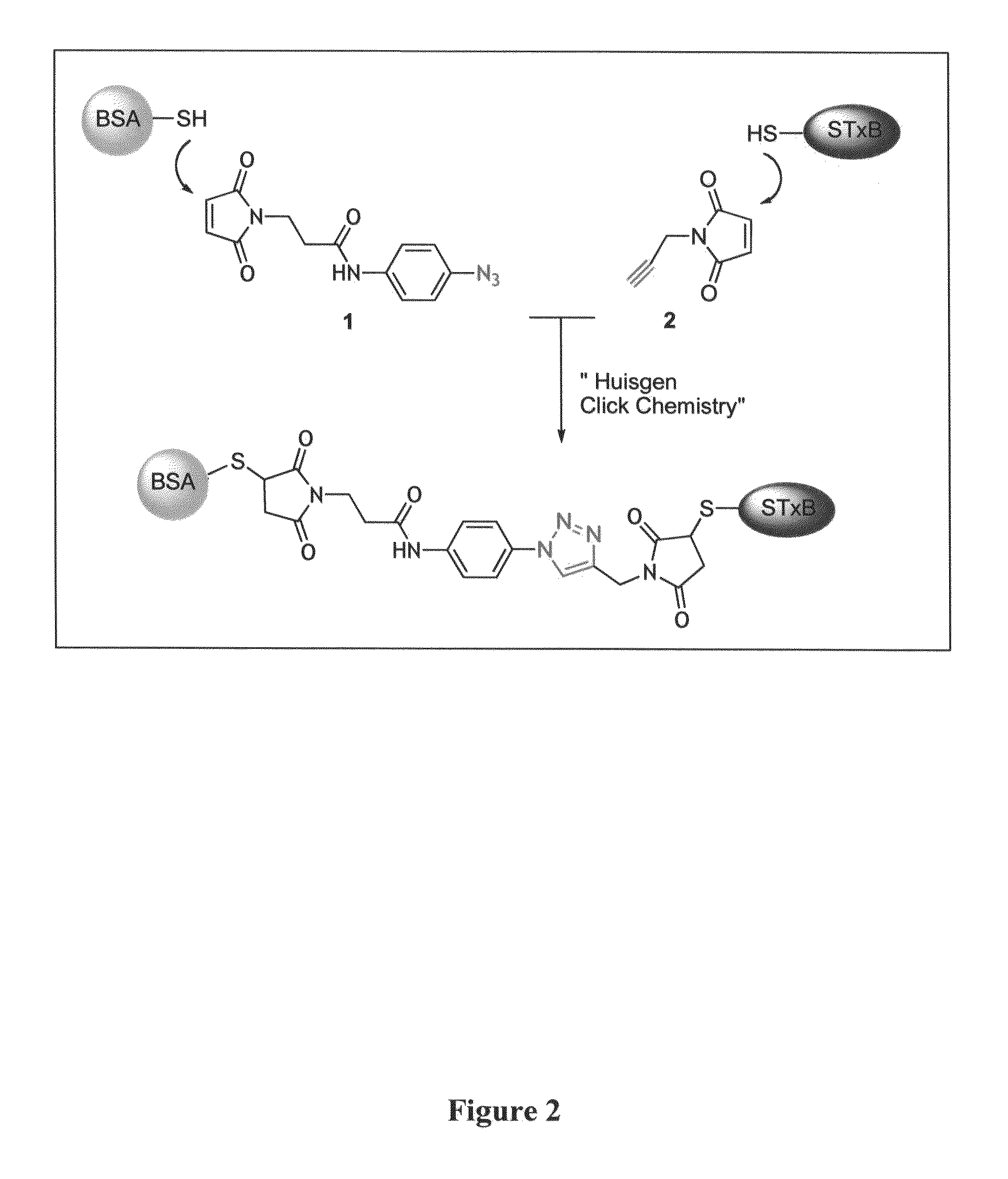Methods and compositions for the preparation and use of toxin conjugates
- Summary
- Abstract
- Description
- Claims
- Application Information
AI Technical Summary
Benefits of technology
Problems solved by technology
Method used
Image
Examples
example 1
Preparation and Testing of an StxB-BSA Conjugate
[0165]The preparation of a well defined coupling product between STxB and a model protein, bovine serum albumin (BSA) is described in this first example (see FIG. 2). BSA was used as the model for several reasons: BSA is a medium size protein which contains several cysteines and that is commercially available. As shown on the scheme presented on FIG. 2, preparation of the STxB-BSA conjugate involves labeling of STxB / Cys with a spacer bearing an alkyne, labeling of BSA with a spacer bearing an azido group and reacting the modified STxB / Cys and modified BSA using the Huisgen Click chemistry.
[0166]Two functional spacer arm compounds capable of reacting with free sulfhydryl groups on cysteines were synthesized. The first spacer, 1, is a maleimido-aryl-azide. This compound was used to functionalize BSA (J. Janatova et al., J. Biol. Chem., 1968, 243: 3612-3622; K. L. Heredia et al., J. Am. Chem. Soc., 2005, 127: 16955-16960). The second spac...
example 2
Preparation and Testing of an STxB-E7 Conjugate
[0172]A second coupling agent was prepared between STxB and the E7 protein. The HPV E7 proteins are small (HPV16 E7 comprising 98 amino acids), zinc binding phosphoproteins which are localised in the nucleus. They are structurally and functionally similar to the E1A protein of subgenus C adenoviruses. The first 16 amino-terminal amino acids of HPV16 E7 contain a region homologous to a segment of the conserved region 1 (CR1) of the E1A protein of subgenus C adenoviruses. The next domain, up to amino acid 37, is homogenous to the entire region 52 (CR2) of E1A. Genetic studies have established that these domains are required for cell transformation in vitro, suggesting similarities in the mechanism of transformation by these viruses. The CR2 homology region contains the LXCXE motif (residues 22-26) involved in binding to the tumor suppressor protein pRb. This sequence is also present in SV40 and polyoma large T antigens. The high risk HPV ...
example 3
Preparation and Testing of Conjugate STxB-Her2 / neu
[0179]The cDNA coding for the extracellular domain of Her2 / neu (see sequence below —SEQ ID 1) is modified at the 5′ end to encode an additional Cys. The protein is expressed in an appropriate host to assure formation of disulfide bonds and glycosylation. Appropriate hosts are Pichia pasteuris and mammalian cell lines such as Chinese hamster ovary cells. The purified Her2 / neu is reacted at 0.5 mg / mL with maleimido-NHS-N3 linker at a molar ratio of 1:3. After removal of the non reacted linker, one equivalent of Her2 / neu-N3 protein (0.5 mg / mL) is then reacted with one equivalent of STxB-alzine (4.5 mg / mL) in presence of an excess of ascorbic acid and cupper, with bathophenontrolin as a cupper ligand. The reaction is carried out overnight at room temperature and a sample is used to perform a Western blot using antibodies against STxB and Her2 / neu proteins.
SEQ ID 1: CTQVCTGTD MKLRLPASPE THLDMLRHLY QGCQVVQGNLELTYLPTNAS LSFLQDIQEV QGYVLIAHN...
PUM
| Property | Measurement | Unit |
|---|---|---|
| Biological properties | aaaaa | aaaaa |
| Immunogenicity | aaaaa | aaaaa |
| Covalent bond | aaaaa | aaaaa |
Abstract
Description
Claims
Application Information
 Login to View More
Login to View More - R&D
- Intellectual Property
- Life Sciences
- Materials
- Tech Scout
- Unparalleled Data Quality
- Higher Quality Content
- 60% Fewer Hallucinations
Browse by: Latest US Patents, China's latest patents, Technical Efficacy Thesaurus, Application Domain, Technology Topic, Popular Technical Reports.
© 2025 PatSnap. All rights reserved.Legal|Privacy policy|Modern Slavery Act Transparency Statement|Sitemap|About US| Contact US: help@patsnap.com



